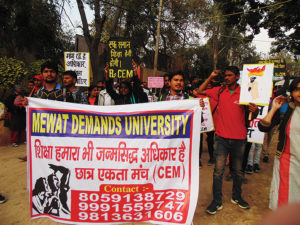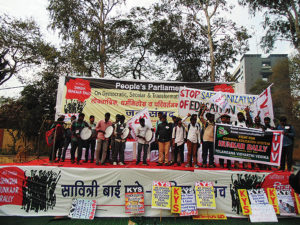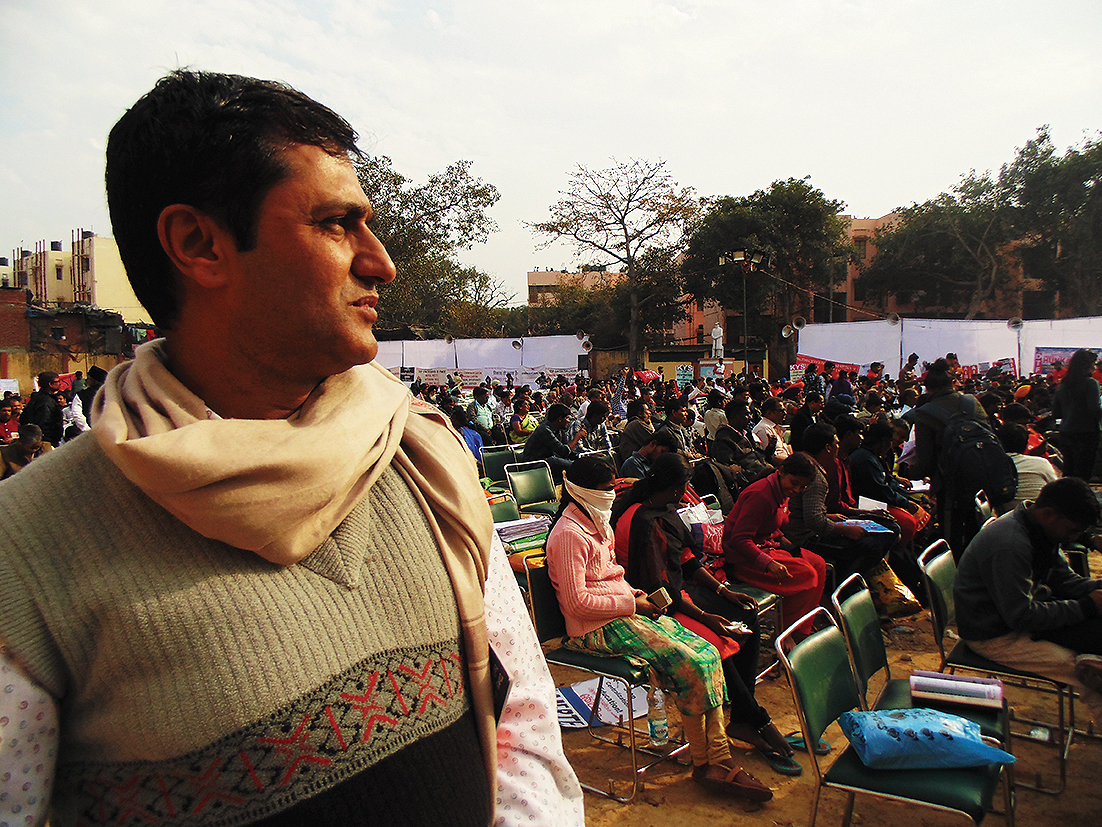In a recent protest rally in the Capital, hundreds of children and activists raised their voice for free and equal education. A system where every student gets the same opportunities
For a mid-February day, the blazing sun was not unusual, not for Delhi. For the hundreds marching from Sansad Marg — where they had earlier gathered for a protest — to Ambedkar Bhavan, it would not have mattered whether it rained or the sun shone.
They were together raising their voice for what mattered to them — the common cause: fair, free and equal education. Their regions, religions, age or occupation of no concern.
As the protestors gathered on the grounds, they sang and shouted against what according to them has become a part of the system –commercialisation through private institutes.
One such group was the Tarksheel Society, Punjab. Its 20 members had started their journey at 1:50 am on Monday from Barnala to reach Delhi by 8 am. With little to no rest, they were at the march at Sansad Marg by 10 am.
For Rajendra Badaud, the organisational head at the society, fatigue has been unable to take over because “they have a cause such as this in hand”.
While primarily their work is to decimate superstitions since its inception in 1984, their demand here is for equal education; the current system talks only about right to education but not the right to get an equitable one, says Badaud, who works as a teacher.

The present situation is quite dismal. For instance, the Punjab government conducted a study last year which found that out of its 24,81,240-government schoolgoing children, almost 5 lakh (4,96,028) were in classrooms without furniture. The age group with the most number of affected were from class 1 to 5 with 2,90,267 followed by 89,137 from classes 6 to 7.
It’s no surprise then that the same year a study was reported by a daily newspaper on how enrolment to government schools in Punjab was declining. It said that from primary to senior secondary level, the numbers had declined by 2.06 lakh students in the past five years. In 2013-14, there were 26.41 lakh students studying in government schools from primary to senior secondary level, but it had reduced to just 24.34 lakh in 2017-18.
When the government is unable to provide a basic facility such as this, then surely it cannot say that equal means are being provided for all students. The parents who have the money would not send their ward to a school without furniture and those who don’t have enough means don’t have any other alternative.
Speaking to the National Executive member from All-India Forum for Right to Education (AIFRTE), which organised the demonstration, Shyam Sonar believes that the Right to Education Act has failed. “In Maharashtra about 20-25 lakh children were unable to move from 7th grade to 8th in government schools.” Thus, they were unable to avail their right to free education. In the country as a whole, he says, crores of students were affected.
According to the Economic Survey 2016-2017, Maharashtra had 160 lakh children in its elementary schools (classes 1 to 8), the number studying in secondary schools (classes 9-12) was drastically lower with 66.15 lakh children.
The Bhopal Shehri Mazdoor Organisation, a group represented at the rally, pointed out that there were shortcomings in the system which was forcing people from SC/ST communities and minorities to drop out.

From the statistics provided by Ministry of Human Resource Development in 2016, the annual drop-out rate at secondary school was 17.86 percent. Out of this, the number of students from Schedule Caste (SC) who dropped out was 18.66 percent and even higher amongst Schedule Tribe (ST) students at 27.20 percent.
The ones who did make it to senior secondary education then dropped out at 2.20 percent. While SC students’ annual drop-out rate was 1.81 percent and for ST students 2.94 percent.
Pallav, who works with de-notified nomad tribes in this organisation, says that they want to use the platform to voice how tribals as a community are being “pushed out of the system”. Pointing to poor government school education and then poor job opportunities, what they want first is “our children getting the same opportunities as those children of a certain class get”. So that a boss’ child and the worker’s child can study in the same school where they receive the same opportunities.
His work has allowed him to learn about the problems that an economically weaker child faces in schools. “They cannot afford private schools and inside government schools they have no acceptance.” They face discrimination everywhere they go,he accuses.
This is also a reason why there are a high number of schools dropouts in Bhopal, Pallav says. “Even the teaching is not relatable.” Giving an example through allegory, he says: “You tell a child that rains are great. But if this child is from a poor background, has never eaten pakoras during rain and instead sees his home getting wet because there is no proper roof over her head. What will she understand?” Such is the curriculum, he says, that a child is unable to comprehend what she is learning. Furthermore, he points to the low level of skill in reading and writing of government educated
children.
The annual status of education report (ASER) found that even in 2018, only a quarter of all children in third grade were at ‘grade level’, which meant “that a majority of children need immediate help in acquiring foundational skills in literacy and numeracy”. These findings relate to government schools only.
It further said that one out of four children who were leaving 8th grade (which would come under the right to education, which is till 14 years of age) did so without acquiring basic reading skills. It warned that these students were leaving the grade without being prepared for higher studies or for the labour market — which is allowed in the country by age 14.
At the moment, the provision in the Constitution does not seem to be helping a large number of children. Would budget allocation help? The forum thinks so, at least with a total 10 percent for education. And free education from kindergarten to postgraduation, nation-wide; giving a real chance to individuals to rise beyond their inherited standards of life.
Presently, the numbers are not looking great with budget allocation dropping in 2018-19 to 3.48 percent which has fallen from 3.71 percent in 2017-18. In 2014-15, the budget allocation was 6.15 percent.
The interim Union Budget 2019-20 announced by Piyush Goyal allocated Rs 38,572 crore for National Education Mission. He also announced the allocation of Rs 27,584 crore for Integrated Child Development Scheme (ICDS) in 2019-20.
The one resounding and undebatable truth is that students do not receive an equal quality of education. Many government schools have a shortage of teachers, textbooks and even the basic provisions of toilets, and chairs and tables. Once the government is able to provide this, perhaps the conversation can shift to free public education till postgraduation.





